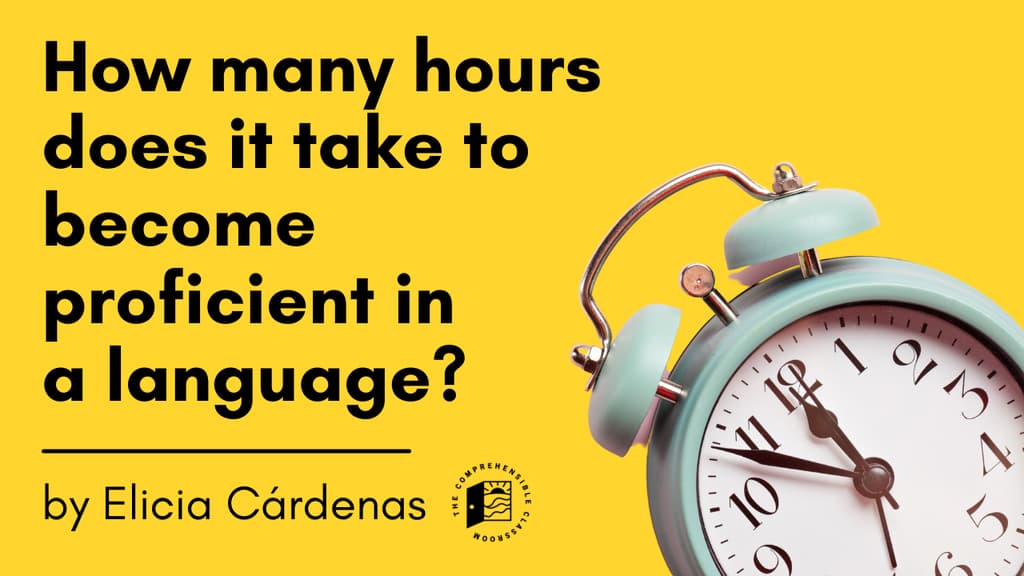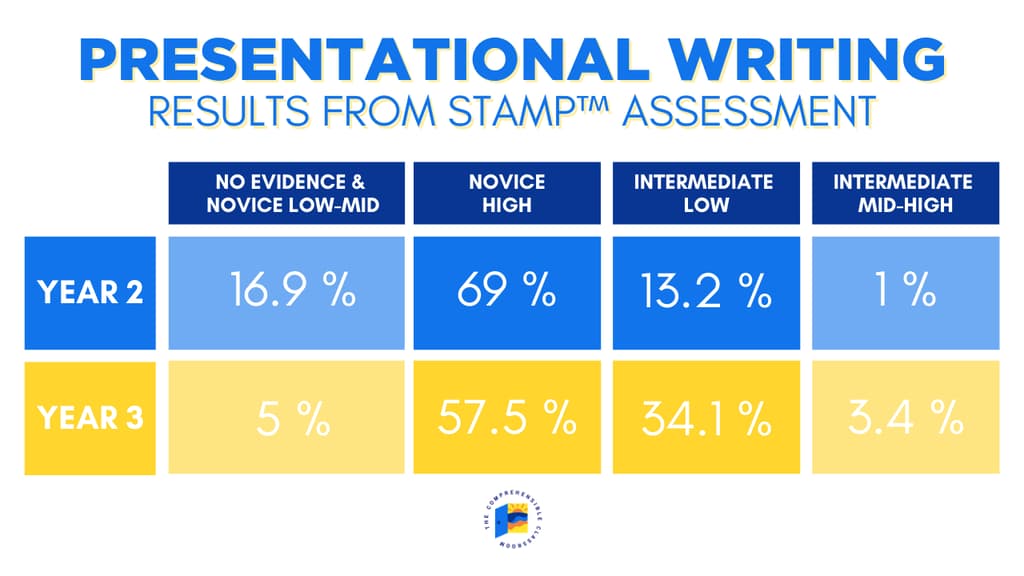As language teachers begin to consider implementing Standards Based Grading, a question quickly arises: what standards should I be grading?
Typically, Standards Based Grading in language classes means basing student grades on their interpretive, presentational, and possibly interpersonal performance on summative assessments. Students complete interpretive reading and listening tasks and presentational writing and/or speaking tasks, and the teacher evaluates their performance in relation to rubrics that are aligned with performance indicators from ACTFL or the CEFR. Here is an example of what this might look like:
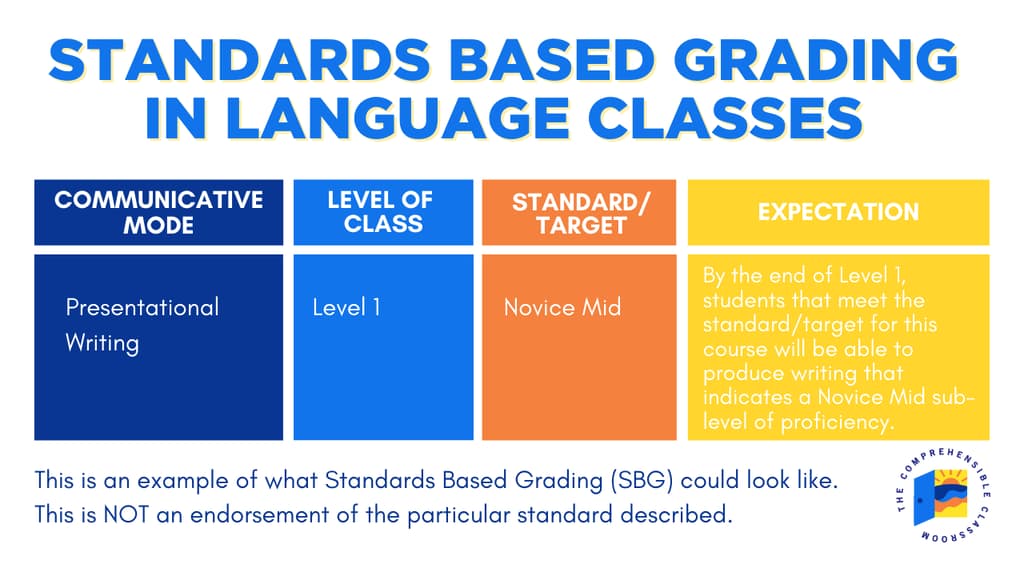 *Note: ACTFL’s performance indicators are not broken down into sub-levels. For that reason, we often use language from the Proficiency Descriptors in grading rubrics, even though we are using that language to describe student performance within a specific context–the context of the language class.
*Note: ACTFL’s performance indicators are not broken down into sub-levels. For that reason, we often use language from the Proficiency Descriptors in grading rubrics, even though we are using that language to describe student performance within a specific context–the context of the language class.
At The Comprehensible Classroom, we advocate for Standards Based Grading practices, and the assessments in our curricula are set up for that vision of assessment.
As you can imagine, one question that quickly arises when transitioning a grading program to Standards Based Grading is what standards should we be setting for a given level? In this blog post, I will walk you through the complicated answer to this question, and it is my hope that you will feel better prepared to set standards and defend those choices by the time you finish reading.
How many hours to reach proficiency?
Post by Elicia Cárdenas, Director of Training
The first question we must answer is how many hours are required to reach a given level of proficiency. If we want to know what standard to set, we need to know how much time it should take a language learner to reach, for example, the Advanced Low level of Presentational Speaking. It is true that “student proficiency is a direct result of instructional hours. If high results are desired, then adequate time must be built into the program as the first step. Only after adequate time is allotted can other issues be addressed.” (CASLS, 2010). But… how much time should be allotted?
Before we even begin to pursue an answer to this question, however, we need to do it with one giant disclaimer: WE MUST KEEP IN MIND THE FACT THAT EVERY HUMAN ACQUIRES LANGUAGE AT A DIFFERENT RATE. A 2010 report by the Center for Applied Second Language Studies (CASLS) at the University of Oregon reminds us that:
 ID: "The question of how long students need to learn another language implies that there is one answer that will apply to every student, which of course isn't true" - Center for Applied Second Language Students, University of Oregon
ID: "The question of how long students need to learn another language implies that there is one answer that will apply to every student, which of course isn't true" - Center for Applied Second Language Students, University of Oregon
Some students need longer than others for a variety of reasons; for that reason, there is not one answer to the question of how long students need to learn another language. Guidelines for proficiency vary, but the following documents may prove useful for making recommendations. First, let’s look at elementary-age students.
How long does it take elementary students to become proficient?
Ohio’s Department of Education recommends the following proficiency targets for Spanish & French Elementary programs that meet a minimum of 3 times a week for a minimum of 90 minutes (approximately 60 hours per year). Unfortunately, there does not appear to be any information available on the website about what, if any, data were used in determining these targets.
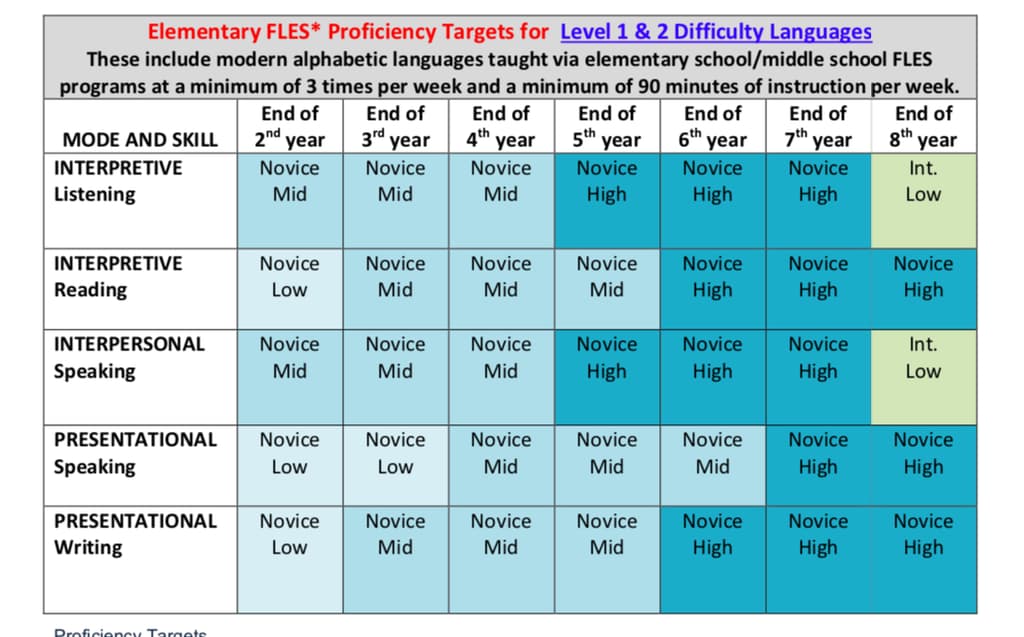
By the end of the 5th year in an elementary FLES program, the Ohio Department of Ed has set the presentational writing target is Novice mid. One question that needs to be asked is what percentage of students meet this goal, and how their progress is assessed. Without this information, it is difficult to make a comparison between programs and desired outcomes. As the document reminds us, “These targets are intended to provide local language programs with informed guidance and should in no way be construed as a state mandate.”
Students in an elementary program who receive 90 minutes of instruction per week for 5 years will receive the equivalent of 300 hours of instruction. However, that number of instructional hours must also be looked at with a critical lens. The key question to answer is this: how much time is spent in communicative events in which students are receiving rich, context embedded language that they can process? Here are some common things that happen in language classes that chip away at the kind of instructional time that is useful for language acquisition:
- time spent in transitions (entering the room, preparing to leave, and transitioning from one activity to the next)
- cutting, coloring, gluing
- playing games or singing without attention to meaning
- reading texts with text coverage below the optimal level for vocabulary grammar growth (texts in which students understand less than 95% of the words)
- instructional loss due to special schedules, assemblies, days off, vacations, field trips, etc.
When we take into consideration all of these uses of class time that do not, or do not necessarily, provide students with processable language data, it becomes apparent that the number of minutes allotted to class do not equal the number of minutes that are actually spent doing the work of language acquisition: engaging in communicative events that will provide the data that students need to acquire language.
How long does it take high school students to become proficient?
Turning our gaze to high school-aged students, one source of data is a 2010 paper from The Center for Applied Second Language Studies at the University of Oregon. The paper examines a study using high school students as assessed by Avant Assessment’s STAMP™ (STAndards-based Measurement of Proficiency) test. Their study suggests that for high school students, within a range of hours (90-180) for year 1, 58 percent of the students assessed were able to achieve a proficiency target of novice high in presentational writing.
In year 2, (defined as cumulatively 270-360 hours), 69 percent of students reached Novice High in presentational writing, and only 13.2 percent achieved a rating of Intermediate Low. In year 3, the equivalent of 450-540 instructional hours, the number of students who reach Intermediate Low in presentational writing grows to 34.1 percent, and 57.5 percent of students now test at to Novice High.
Looking at this data with a critical lens, we must notice that a range of instructional hours is provided for each year and ask which students received the highest number of hours of instruction and what percentage received the lowest. Was there a correlation between the number of instructional hours and performance? We also must keep in mind that this data is from high school students; it may or may not be useful for considering outcomes for elementary or middle school programs.
Can we know how long it should take a student to reach a given level of proficiency?
The biggest question remains: Can we apply this data as evidence for determining proficiency targets? Based on the many unanswered questions presented by this research, I believe that this data is useful as a tool for discussion and further inquiry, but is only moderately useful for making recommendations about performance targets. It is not reasonable to set standards that only a percentage of students are able to/will achieve, based on historical data. This goes against the principles of Standards Based Grading! In a Standards Based Grading model, teachers accept the responsibility for ensuring that all students can meet the standards. The teacher must set standards that all students are able to achieve!
We believe that all students are capable of acquiring another language, and we also believe that students who believe that they are capable will be motivated to continue in their journey to acquire. Nothing motivates students like being successful. Therefore, setting performance targets that the majority of students can reach in a world language is both motivating and a good practice.
The 2010 CASLS report that we cited states that their research shows that “after 630 to 720 hours of instruction, or about midway through the fourth year of study, approximately 14% of students can read at the Intermediate Mid level or better. Approximately 16% can write and 6% can speak at this level”. It would seem reasonable, then, to set the standard for Presentational Writing for Year 4 at or below Intermediate Low, since such a small percentage of students are performing at that Intermediate Mid–yet Novice High seems like such an unglamorous promise after an investment of FOUR YEARS OF YOUR LIFE in studying a language! Does it really make sense to establish that as the standard?
Some teachers are concerned that by setting goals that every student can achieve, that they are somehow reducing expectations and lowering standards. They fear that their course will not be “rigorous” enough to meet the expectations of parents, administrators, and other stakeholders. What I have come to see is that this fear demonstrates that grades are intended to sort the “good students” from the rest. It upholds the false and harmful belief that not all students are capable of acquiring another language, despite evidence that the student already acquired communicative proficiency in at least one language.
Unfortunately, historic grading practices in world languages have largely rewarded faster processors, students with strong short-term memories, students who are confident (eager to participate by speaking), and students who are motivated by grammar instruction. Students who do not fall in these categories are often penalized for not being able to memorize word lists, for not being able to apply explicitly taught grammar rules to discrete tasks, or for choosing not to participate in discussions where they may feel judged or left behind. As a profession, we need to look carefully at what we are grading, who benefits from our grading policies and performance targets, and who is penalized.
What is the purpose of grading?
As teachers and administrators, we have to ask ourselves: what do we want our grades to accomplish? Are grades meant to sort our students into groups for manual labor or management (as the 0-100% scale was originally developed to do over a century ago) or do we want them to be indicators of what students can do, and possibly even celebrations of student progress? Do we want grades to be incentives, or do we want them to be information? Is there a problem with all students being able to reach and potentially exceed performance targets? What harm will that cause? Remember– we are talking about performance targets, not ceilings. These are all real questions with which each department must wrestle.
At The Comprehensible Classroom, we believe that setting reasonable performance targets that the vast majority of students can reach is a good practice. We want to create motivated learners who believe that they are capable of acquiring a language, to give them the data that they need for language acquisition (input, in the target language, that they understand), and to celebrate what they can do. Writer and educator Joe Feldman sums up our beliefs:
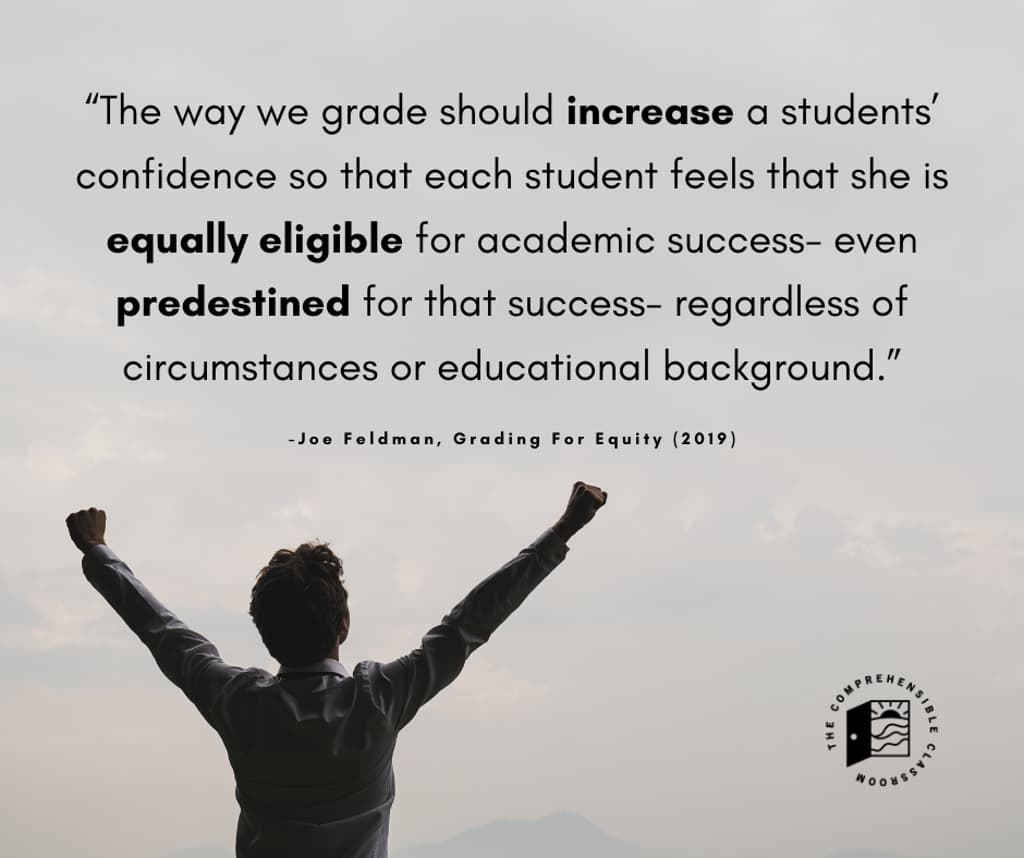 “The way we grade should increase a students’ confidence so that each student feels that she is equally eligible for academic success- even predestined for that success- regardless of circumstances or educational background.”
“The way we grade should increase a students’ confidence so that each student feels that she is equally eligible for academic success- even predestined for that success- regardless of circumstances or educational background.”
-Joe Feldman, Grading For Equity (2019)
Set the time, then use the time.
Looking at the seat time for language classes in your program and considering what standards are reasonable for ALL students to achieve based on the time available is only the first step. Assessment and grading is so critical because it has historically been used as a tool to punish some students and reward others. Historically, it has instilled in millions of students the false belief that they just aren’t good at language. Set standards that make ALL students in your school believe that they are capable of learning another language, and then you can focus on the fun stuff: instructional practices that will help them to reach the standard. CASLS reminds us that “All instructional time is not created equal. Methods and textbooks [...] are refining issues to be decided after adequate time is scheduled. Of course, even adequate time can be frittered away on activities that do not promote proficiency. If proficiency is the goal, the question for every decision becomes, “How will this improve proficiency?””
Get the kids in class, keep the kids in class, and then use that class time to create rich communicative events.
ABOUT THE AUTHOR: Elicia Cárdenas is the Director of Training for the Comprehensible Classroom. She leads workshops on Assessment and Grading Practices in World Language Classes to districts and individuals.

